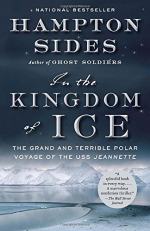|
This section contains 597 words (approx. 2 pages at 400 words per page) |

|
In the Kingdom of Ice Summary & Study Guide Description
In the Kingdom of Ice Summary & Study Guide includes comprehensive information and analysis to help you understand the book. This study guide contains the following sections:
This detailed literature summary also contains Topics for Discussion on In the Kingdom of Ice by Hampton Sides.
The Kingdom of Ice is the story of the ill-fated De Long Expedition to the North Pole that was launched with great hope and excitement from San Francisco in 1880. Little was known about the Arctic region and virtually nothing was known about the North Pole. There were what are known now to be bizarre theories that were commonly held about the Pole by respected scientists, military men and other experts.
August Petermann a world-renowned cartographer and geographer was one of many Arctic “experts” who believed that there was warm water surrounding the North Pole. These waters were referred to as the Open Polar Ocean intimating that the waters were free of ice floes and packs and were “open” to vessels that would not be encumbered by ice. The warm waters of this ocean were the result of the conflagration of the warm Gulf stream and the Kuro Siwo, the warm black current that flowed northward to the Bering Strait from Japan and Formosa.
The saga of the USS Jeannette and its crew on an expedition to reach the North Pole, a region never before seen by man, has a hint of a “perfect storm” scenario. For one, there was avid interest in exploring the North Pole from scientists, explorers and the public alike. There had been failed expeditions and tragedies like the Polaris expedition which resulted in an apparent mutiny with the commander, Captain Charles Hall, being poisoned with arsenic after the ship had been stranded in ice.
But those and other expedition failures didn’t dampen the fervor for reaching the North Pole. Multimillionaire James Bennett was the owner and editor-in-chief of the New York Herald which in the late nineteenth century was the most influence newspaper in the world. Bennett was interested in the exploration of the North Pole on an intellectual level; he was also seeking out the next hot story for his newspaper. Bennett had orchestrated reporter Sir Henry Stanley’s successful mission to locate Dr. David Livingstone who had been abandoned in Africa.
Bennett believed that by sponsoring a North Pole expedition and having exclusivity for reports dispatched from the trek would increase his readership and elevate the stature of his newspaper to a new level. He was willing to fund the entire expedition. Bennett met with Petermann to get advice about the best route to take to the North Pole. Petermann gladly cooperated and willingly provided all the charts and maps that would be necessary for such a journey.
Navy Lieutenant George De Long was an explorer at heart. He was already a celebrated American hero having saved an abandoned expedition to Greenland. He was obsessed with the North Pole and exploring it. He wanted to be the first adventurer to arrive there and proudly claim it for the U.S. De Long had the passion, Bennett had the money and Petermann had the maps. Without those three convergent drivers, the expedition would not have happened.
Reality trumps speculation every time. When De Long and his crew began to encounter ice on their journey north, they discovered that Petermann and other advocates of the Kuro Siwo and Open Polar Ocean had it all wrong. They came to realize that there was nothing but ice, fifteen feet thick at times, all the way to the North Pole. The USS Jeannette got hopelessly stuck in the ice. The men eventually abandoned ship and traveled on foot, by dog sled and by small whaling boats in an effort to reach the Siberian mainland some one thousand miles away and save their lives.
Read more from the Study Guide
|
This section contains 597 words (approx. 2 pages at 400 words per page) |

|



